GENERAL ELECTRIC PFSS2MJXSS, PFSS2MIXSS, PFSF2MJXWW, PFSF2MJXBB, PFSF2MIXWW User Manual
...
RefrigeratorsProfile Bottom Freezer
GEAppliances.com
Safety Instructions . . . . . . . . . . .2, 3
Operating Instructions
Additional Features . . . . . . . . . . . . . . . . .9 Automatic Icemaker . . . . . . . . . . . . . . .12 Care and Cleaning . . . . . . . . . . . . .13–14 Controls . . . . . . . . . . . . . . . . . . . . . . . . . .4–5 Crispers and Pans . . . . . . . . . . . . . . . . .10 Freezer . . . . . . . . . . . . . . . . . . . . . . . . . . . .11 Replacing the Light Bulbs . . . . . . . . . .15 Shelves and Bins . . . . . . . . . . . . . . . . . .8, 9 Water Filter . . . . . . . . . . . . . . . . . . . . . .6, 7
Installation Instructions
Installing the Refrigerator . . . . . .17–21 Installing the Water Line . . . . . . . .30–32 Preparing to Install
the Refrigerator . . . . . . . . . . . . . . . . . . . .16 Removing and Replacing
the Doors (Double Door
Refrigerator Models only) . . . . . . .27–29 Removing and Replacing the
Freezer Drawer . . . . . . . . . . . . . . . .22, 23 Reversing the Door Swing
(Single Door Refrigerator
Models only) . . . . . . . . . . . . . . . . . . .24–26
Troubleshooting Tips . . . . . .33–37 Normal Operating Sounds . . . . . . . . . .33
Consumer Support
Consumer Support . . . . . . . .Back Cover Performance Data Sheet . . . . . . .43, 44 State of California Water
Treatment Device Certificate . . .45, 46 Warranty for Canadian
Customers . . . . . . . . . . . . . . . . . . . . . . . . .42 Warranty for U.S. Customers . . . . . . .41
Owner’s Manual and
Installation Instructions
Models 20, 22 and 23
Congélateur inférieur
Réfrigérateurs
Manuel d’utilisation et d’installation
La section française commence à la page 47
Congelador inferior
Refrigeradores
Manual del propietario e instalación
La sección en español empieza en la página 89
Write the model and serial numbers here:
Model # ____________________
Serial #______________________
Find these numbers on a label
on the right side, near the top of the refrigerator compartment.
200D9366P016 49-60603-2 09-11 GE
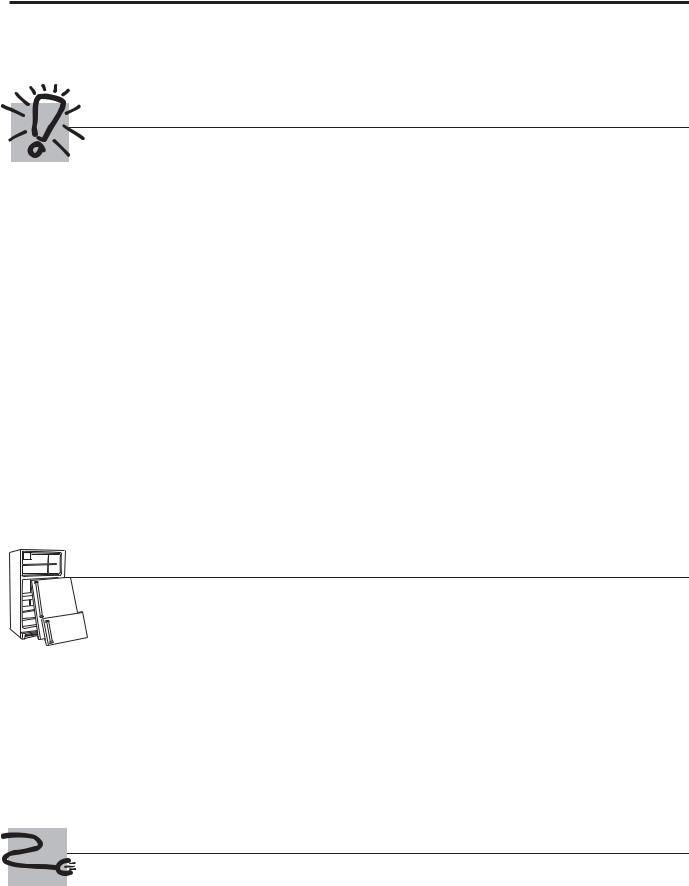
IMPORTANT SAFETY INFORMATION.
READ ALL INSTRUCTIONS BEFORE USING.
 WARNING!
WARNING!
Use this appliance only for its intended purpose as described in this Owner’s Manual.
SAFETY PRECAUTIONS
When using electrical appliances, basic safety precautions should be followed, including the following:
This refrigerator must be properly installed and located in accordance with the Installation Instructions before it is used.
Do not allow children to climb, stand or hang on the shelves in the refrigerator. They could damage the refrigerator and seriously injure themselves.
Do not touch the cold surfaces in the freezer compartment when hands are damp or wet. Skin may stick to these extremely cold surfaces.
Do not store or use gasoline or other flammable vapors and liquids in the vicinity of this or any other appliance.
Keep fingers out of the “pinch point” areas; clearances between the doors and between the doors and cabinet are necessarily small. Be careful closing doors when children are in the area.
In refrigerators with automatic icemakers, avoid contact with the moving parts of the ejector mechanism, or with the heating element that releases the cubes. Do not place fingers or hands on the automatic icemaking mechanism while the refrigerator is plugged in.
Unplug the refrigerator before cleaning and making repairs.
NOTE: We strongly recommend that any servicing be performed by a qualified individual.
Setting either or both controls to 0 (off) does not remove power to the light circuit.
Do not refreeze frozen foods which have thawed completely.
 DANGER! RISK OF CHILD ENTRAPMENT
DANGER! RISK OF CHILD ENTRAPMENT
PROPER DISPOSAL OF THE REFRIGERATOR
Child entrapment and suffocation are not problems of the past. Junked or abandoned refrigerators are still dangerous…even if they will sit for “just a few days.”
If you are getting rid of your old refrigerator, please follow the instructions below to help prevent accidents.
Before You Throw Away Your Old Refrigerator or Freezer:
Take off the doors.
Leave the shelves in place so that children may not easily climb inside.
Refrigerants
All refrigeration products contain refrigerants, which under federal law must be removed prior to product disposal. If you are getting rid of an old refrigeration product, check with the company handling the disposal about what to do.
USE OF EXTENSION CORDS
Because of potential safety hazards under certain conditions, we strongly recommend against the use of an extension cord.
|
However, if you must use an extension cord, it is absolutely necessary that it be a UL-listed (in the United States) |
|
or a CSA certified (in Canada), 3-wire grounding type appliance extension cord having a grounding type plug |
2 |
and outlet and that the electrical rating of the cord be 15 amperes (minimum) and 120 volts. |

GEAppliances.com
 WARNING!
WARNING!
HOW TO CONNECT ELECTRICITY
Do not, under any circumstances, cut or remove the third (ground) prong from the power cord. For personal safety, this appliance must be properly grounded.
The power cord of this appliance is equipped with a 3-prong (grounding) plug which mates with a standard 3-prong (grounding) wall outlet to
minimize the possibility of electric shock hazard from this appliance.
Have the wall outlet and circuit checked by a qualified electrician to make sure the outlet is properly grounded.
Where a standard 2-prong wall outlet is encountered, it is your personal responsibility and obligation to have it replaced with a properly grounded 3-prong wall outlet.
The refrigerator should always be plugged into its own individual electrical outlet which has a voltage rating that matches the rating plate.
This provides the best performance and also prevents overloading house wiring circuits which could cause a fire hazard from overheated wires.
Never unplug your refrigerator by pulling on the power cord. Always grip plug firmly and pull straight out from the outlet.
Repair or replace immediately all power cords that have become frayed or otherwise damaged. Do not use a cord that shows cracks or abrasion damage along its length or at either end.
When moving the refrigerator away from the wall, be careful not to roll over or damage the power cord.
USE OF ADAPTER PLUGS
Adapter plugs are not permitted in Canada.
READ AND FOLLOW THIS SAFETY INFORMATION CAREFULLY.
SAVE THESE INSTRUCTIONS
3
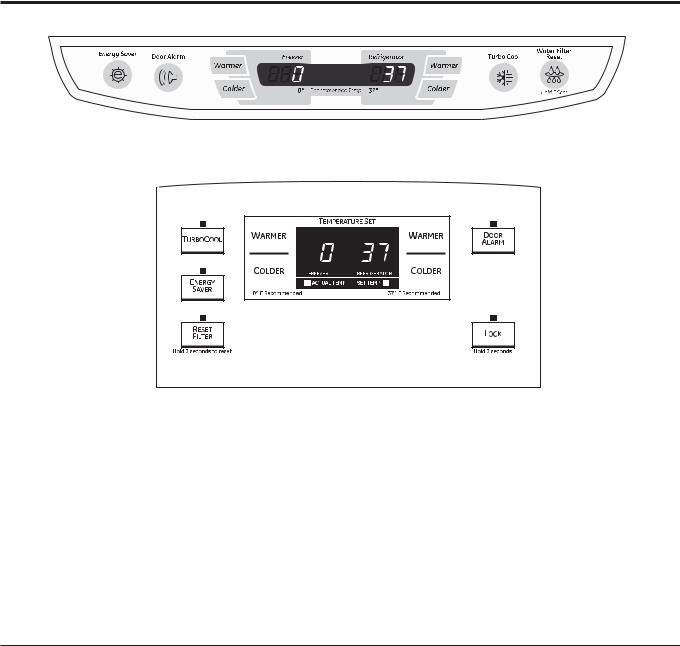
About the controls with temperature settings.
(on some models)
(on some models)
NOTE: The refrigerator is shipped with protective film covering the temperature controls. If this film was not removed during installation, remove it now.
The temperature controls are preset in the factory at 37°F for the refrigerator compartment and 0°F for the freezer compartment. Allow 24 hours for the temperature to stabilize to the preset recommended settings.
The temperature controls can display both the SET temperature as well as the actual temperature in the refrigerator and freezer. The actual temperature may vary slightly from the SET temperature based on usage and operating environment.
Setting either or both controls to OFF stops cooling in both the freezer and refrigerator compartments, but does not shut off electrical power to the refrigerator.
|
Changing the Temperature |
|
|
For Controls-on-the-Door Models: |
|
|
To change the temperature, press and release the |
|
|
WARMER or COLDER pad. The ACTUAL TEMP light |
|
|
will come on and the display will show the actual |
|
|
temperature. To change the temperature, tap either |
|
|
the WARMER or COLDER pad until the desired |
|
|
temperature is displayed. |
|
|
For Controls Inside the Refrigerator: |
|
|
Opening the door displays the actual temperature. |
|
|
To change the temperature, press either the |
|
|
WARMER or COLDER touch pads until the |
|
|
desired temperature is displayed. |
|
|
Once the desired temperature has been set, |
|
|
the temperature display will return to the actual |
|
4 |
refrigerator and freezer temperatures after 5 |
|
seconds. Several adjustments may be required. |
||
|
Each time you adjust controls, allow 24 hours for the refrigerator to reach the temperature you have set.
To turn the cooling system off, tap the WARMER pad for either the refrigerator or the freezer until the display shows OFF. To turn the unit back on, press the COLDER pad for either the refrigerator or freezer. Then press the COLDER pad again and it will go to the preset points of 0°F for the freezer and 37°F for the refrigerator. Setting either or both controls to OFF stops cooling in both the freezer and refrigerator compartments, but does not shut off electrical power to the refrigerator.
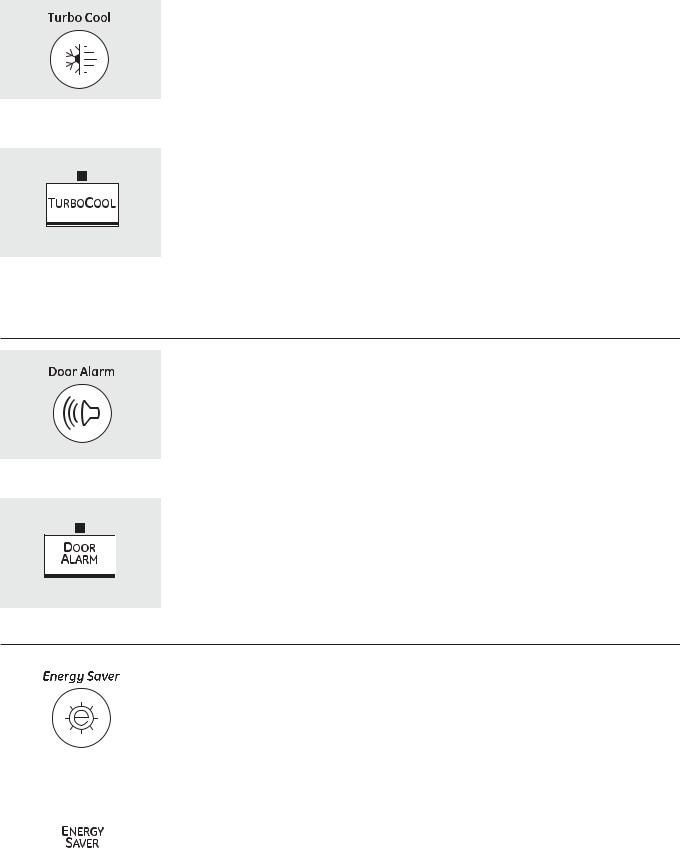
About TurboCool.™ (on some models) |
GEAppliances.com |
(on some models)
(on some models)
How it Works
TurboCool rapidly cools the refrigerator compartment in order to more quickly cool foods. Use TurboCool when adding a large amount of food to the refrigerator
compartment, putting away foods after they have been sitting out at room temperature or when putting away warm leftovers. It can also be used if the refrigerator has been without power for an extended period.
Once activated, the compressor will
turn on immediately and the fans will cycle on and off at high speed as needed for eight hours. The compressor will continue to run until the refrigerator compartment cools to approximately 34°F (1°C), then it will cycle on and off to maintain this setting. After 8 hours, or if TurboCool is pressed again, the refrigerator compartment will return
to the original setting.
How to Use
Press TurboCool. The refrigerator temperature display will show
 .
.
After TurboCool is complete, the refrigerator compartment will return to the original setting.
NOTES: The refrigerator temperature cannot be changed during
TurboCool.
The freezer temperature is not affected during TurboCool.
When opening the refrigerator door during TurboCool, the fans will continue to run if they have cycled on.
About Door Alarm (on some models)
The door alarm will sound if any door is open for more than 2 minutes. The beeping stops when you close the door.
(on some models)
(on some models)
|
|
|
|
|
|
About Energy Saver (on some models) |
|
|
|
|
|
|
|
||
|
|
|
|
|
|
This product is equipped with an Energy |
|
|
|
|
|
|
|
Saver feature. The refrigerator is shipped with |
|
|
|
|
|
|
|
the Energy Saver feature enabled. |
|
|
|
|
|
|
|
Over time, moisture can form on the front |
|
|
|
|
|
|
|
surface of the refrigerator cabinet and cause |
|
(on some models) |
|||||||
rust. If moisture does appear on the front |
|||||||
|
|
|
|
|
|
surface of the refrigerator cabinet, turn off |
|
|
|
|
|
|
|
the Energy Saver feature by pressing and |
|
|
|
|
|
|
|
releasing the ENERGY SAVER pad on the |
|
|
|
|
|
|
|
||
|
|
|
|
|
|
control panel. |
|
|
|
|
|
|
|
|
|
|
|
|
|
|
|
|
|
|
|
|
|
|
|
|
|
(on some models)
5

About the water filter. (on 22 and 23 models only)
Cartridge 
Holder
Cartridge 
Holder
(on some models)
(on some models)
Water Filter Cartridge
The water filter cartridge is located in the back upper right corner of the refrigerator compartment.
When to Replace the Filter
There is a replacement indicator light for the water filter cartridge on the temperature display. This light will turn orange to tell you that you need to replace the filter soon. The filter cartridge should be replaced when the replacement indicator light turns red or if the flow of water to the dispenser or icemaker decreases.
Installing the Filter Cartridge
If you are replacing the cartridge, first remove the old one by slowly turning it to the left. DO NOT pull down on the cartridge. A small amount of water may drip down.
 CAUTION: If air has been trapped in the system, the filter cartridge may be ejected as it is removed. Use caution when removing.
CAUTION: If air has been trapped in the system, the filter cartridge may be ejected as it is removed. Use caution when removing.
Remove the protective foil from the end of the cartridge.
Fill the replacement cartridge with water from the tap to allow for better flow from the dispenser immediately after installation.
Lining up the arrow on the cartridge and the cartridge holder, slowly rotate the cartridge clockwise until it stops. When the cartridge is properly installed, you will feel it “click” as it locks into place.
Do not overtighten.
Run water from the dispenser for
3 minutes (about 11⁄2 gallons) to clear the system and prevent sputtering. See To Use the Dispenser section.
Press and hold the RESET WATER FILTER pad for 3 seconds.
NOTE: A newly-installed water filter cartridge may cause water to spurt from the dispenser.
Filter Bypass Plug
You must use the filter bypass plug when a replacement filter cartridge is not available. The icemaker will not operate without the filter or filter bypass plug.
Replacement Filters:
To order additional filter cartridges in the United States, visit our Website,
GEAppliances.com, or call GE Parts and Accessories, 800.626.2002.
Filter Model MWF
Customers in Canada should consult the yellow pages for the nearest Mabe Service Center.
6
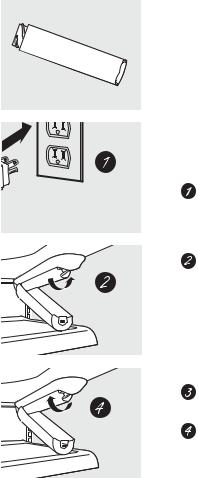
About the water filter. (on 20 models only) |
GEAppliances.com |
|
|
Water Filter Cartridge
The water filter cartridge is located in the back upper right corner of the refrigerator compartment.
When to Replace the Filter
The filter cartridge should be replaced when the flow of water to the icemaker decreases, or every 6 months.
Installing the Filter Cartridge
If you are replacing the cartridge, first remove the old one. Open the cartridge cover by pressing in on the tab at the front and pulling down.
Remove the cartridge by slowly rotating it counterclockwise. A small amount of water may drip down.
 CAUTION: If air has been trapped in the system, the filter cartridge may be ejected as it is removed. Use caution when removing.
CAUTION: If air has been trapped in the system, the filter cartridge may be ejected as it is removed. Use caution when removing.
Remove the protective foil from the end of the cartridge.
Lining up the arrow on the cartridge and the cartridge holder, slowly rotate the cartridge clockwise until it stops. When the cartridge is properly installed, you will feel it “click” as it locks into place. The grip on the end of the cartridge should be positioned vertically.
Do not overtighten.  Close the cartridge cover.
Close the cartridge cover.
Filter Bypass Plug
You must use the filter bypass plug when a replacement filter cartridge is not available. The icemaker will not operate without the filter or filter bypass plug.
Replacement Filters:
To order additional filter cartridges in the United States, visit our Website,
GEAppliances.com, or call GE Parts and Accessories, 800.626.2002.
Filter Model GSWF
Customers in Canada should consult the yellow pages for the nearest Mabe Service Center.
7
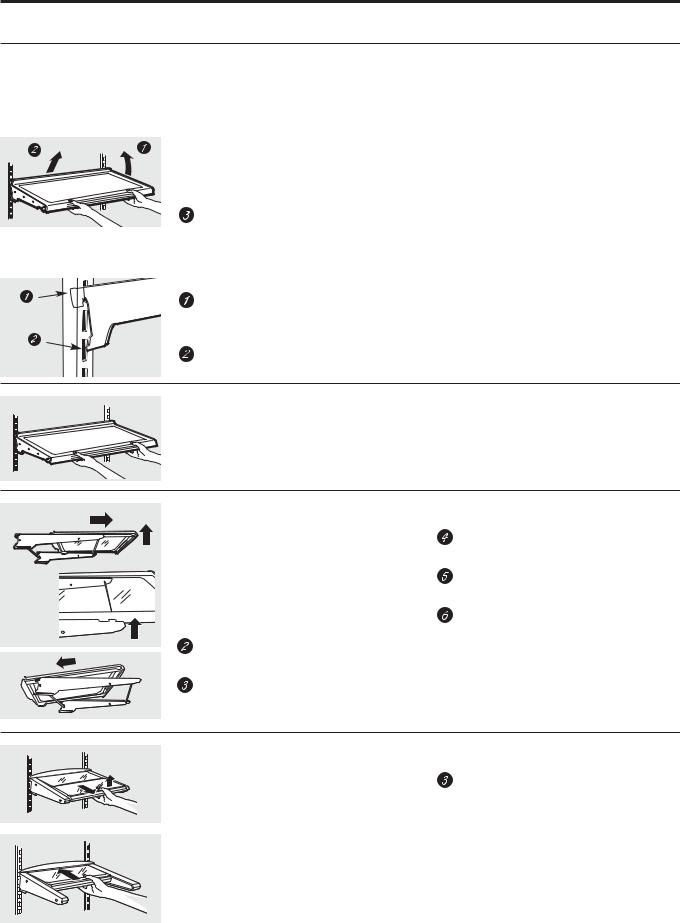
About the shelves and bins.
Not all features are on all models.
Rearranging the Shelves
Shelves in the refrigerator compartment are adjustable.
Refrigerator Compartment
To remove:
 Remove all items from the shelf.
Remove all items from the shelf.
 Tilt the shelf up at the front.
Tilt the shelf up at the front.
Lift the shelf up at the back and
bring the shelf out.
Some models have wire shelves that can be adjusted in the same manner.
To replace:
While tilting the shelf up, insert the top hook at the back of the shelf in a slot on the track.
Lower the front of the shelf until the bottom of the shelf locks into place.
Spillproof Shelves (on some models)
Spillproof shelves have special edges to help prevent spills from dripping to lower shelves. To remove or replace the shelves, see Rearranging the Shelves.
Slide-Out Spillproof Shelf (on some models)
The slide-out spillproof shelf allows you
to reach items stored behind others. The
special edges are designed to help prevent spills from dripping to lower shelves.
To remove:

 Remove all items from shelf.
Remove all items from shelf.
Remove the shelf from the compartment by lifting up and out.
Remove the glass shelf from the frame by sliding the shelf out until it stops.
Pull the shelf up to release it from the front of the frame.
Slide the shelf back to release it from the back of the frame.
To reinstall the glass shelf, reverse these instructions.
Make sure that the shelf sits flat after reinstallation and doesn’t move freely from side to side.
Make sure you push the shelves all the way in before you close the door.
Tuck-Away Shelf (on some models)
This shelf can retract to half its size for storage of tall items on the shelf below.
To remove:
 Pull the shelf out and up.
Pull the shelf out and up.
 Slide the shelf back until it stops.
Slide the shelf back until it stops.
To return the shelf to its original position, pull up and forward on the shelf. Push down slightly to lock the shelf into position.
8
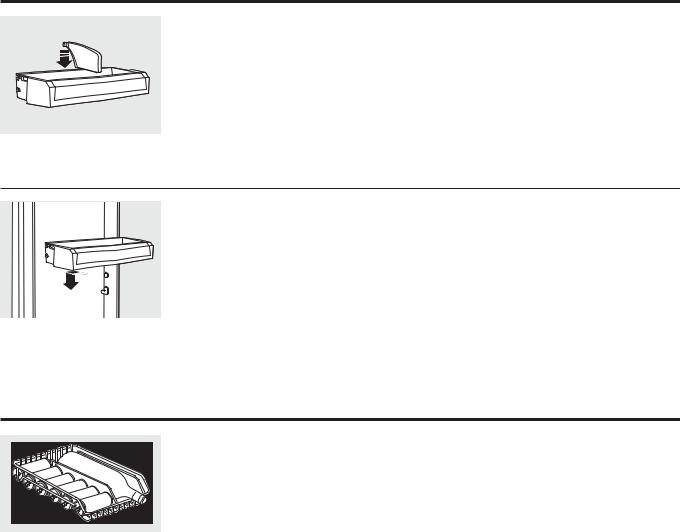
GEAppliances.com
Adjustable Bins on the Door
Adjustable bins can easily be carried from refrigerator to work area.
To remove: Lift bin straight up, then pull out.
To replace or relocate: Slide in the bin just above the molded door supports, and push down. The bin will lock in place.
The snugger helps prevent tipping, spilling or sliding of small items stored on the door shelf. Grip the finger hold near the rear of the snugger and move it to fit your needs.
Non-Adjustable Bins on the Door
To remove: Lift the bin straight up, then pull out.
To replace: Engage the bin in the molded supports on the door and push down.
It will lock in place.
About the additional features.
Shelf Saver Rack (on some models)
Slide-out beverage rack holds twelve cans of soda or two wine/water bottles (lengthwise). It can be removed for cleaning.
To remove, slide the rack out to the stop position, lift the rack up and past the stop position and lift it out.
9

About the crispers and pans.
Not all features are on all models.
Fruit and Vegetable Crisper
Excess water that may accumulate in the bottom of the drawers or under the drawers should be wiped dry.
Adjustable Humidity Crisper (on some models)
Slide the control all the way to the HIGH setting to provide high humidity recommended for most vegetables.
Slide the control all the way to the LOW setting to provide lower humidity levels recommended for most fruits.
Second slot |
from top |
Adjustable Temperature Deli Pan (on some models)
When the pan is placed in the 2nd slot from the top of the track and the lever is set
at COLDEST, air from the freezer is forced around the pan to keep it very cold.
You can move the pan to any location if you don’t want the extra cold storage.
The settings can be adjusted anywhere between cold  and coldest
and coldest 
 .
.
When set at cold, the pan will stay at the normal refrigerator temperature.
The coldest setting provides the coldest storage area.
10

About the freezer. |
GEAppliances.com |
|
Not all features are on all models. |
|
|
Freezer Shelves and Baskets |
|
|
A shelf above the ice storage bin |
NOTE: Do not fill baskets higher than the rim |
|
A half-width basket |
of the basket. This may cause baskets to stick |
|
or jam when opening or closing. |
||
|
||
A shallow full-width basket |
|
|
A deep full-width basket |
|
Appearance and features may vary
Appearance may vary
Appearance may vary
Basket Removal
To remove the deep full-width basket on freezer drawer models:
 Open the freezer drawer until it stops.
Open the freezer drawer until it stops.
The freezer basket rests on the inside tabs on the drawer slides.
Lift the basket so that it is out of all 6 slide bracket tabs.
 Tilt the basket and lift out of the drawer.
Tilt the basket and lift out of the drawer.
To remove the half-width basket:
 Pull the basket out to the stop location.
Pull the basket out to the stop location.
Lift the basket up at the front to release it from the slides.
 Lift the back up and out of the slide.
Lift the back up and out of the slide.
To remove the shallow full-width basket:
 Pull the basket out to the stop location.
Pull the basket out to the stop location.
Lift the front up and over the stop location.
When replacing the deep full-width basket:
Tilt the basket back and lower it down into the drawer. Rotate the basket to a horizontal position and press it down into the 6 alignment tabs.
NOTE: Always be sure that the basket is seated in all 6 slide bracket tabs before sliding back into the freezer. The basket can be turned in either direction front to back and installed into the freezer.
When replacing the basket, make sure that the wire tabs and wire hooks on the sides of the basket go into the slots in the top
of the upper basket slides.
NOTE: Always be sure to fully close this basket.
 Lift the basket up and out.
Lift the basket up and out.
Appearance may vary
11
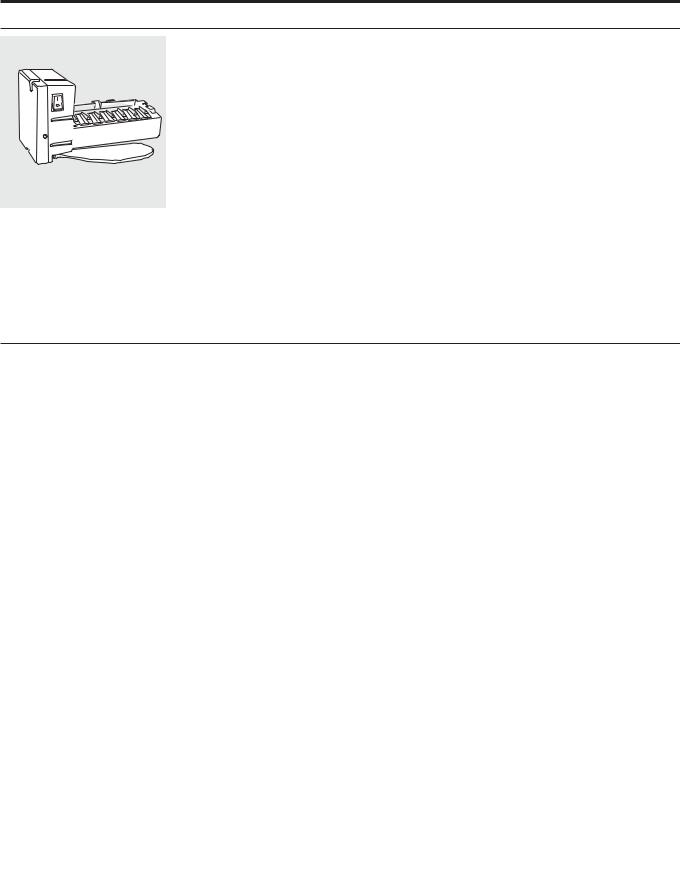
About the automatic icemaker.
A newly installed refrigerator may take 12 to 24 hours to begin making ice.
Power
Switch
Icemaker
Green
Power Feeler Arm
Light
Automatic Icemaker (on some models)
The icemaker will produce seven cubes per cycle— approximately 100–130 cubes in a 24-hour period, depending on freezer compartment temperature, room temperature, number of door openings and other use conditions.
See below for how to access ice and reach the power switch.
If the refrigerator is operated before the water connection is made to the icemaker, set the power switch in the O (off) position.
When the refrigerator has been connected to
the water supply, set the power switch to the l (on) position. The icemaker power light will turn green when the freezer light switch is pressed in or when the freezer door is closed.
The icemaker will fill with water when it cools to 15°F (–10°C). A newly installed refrigerator may take 12 to 24 hours to begin making ice cubes.
You will hear a buzzing sound each time the icemaker fills with water.
Throw away the first few batches of ice to allow the water line to clear.
Be sure nothing interferes with the sweep of the feeler arm.
When the bin fills to the level of the feeler arm, the icemaker will stop producing ice. It is normal for several cubes to be joined together.
If ice is not used frequently, old ice cubes will become cloudy, taste stale and shrink.
NOTE: In homes with lower-than-average water pressure, you may hear the icemaker cycle multiple times when making one batch of ice.
NOTE: Set the power switch to the O (off) position if the water supply is shut off.
Shelf
Ice Bin
To reach the power switch.
Accessing Ice and Reaching the Power Switch
To reach the icemaker power switch, pull the shelf above the ice bin straight out. Always be sure to replace the shelf.
To access ice, simply pull the bin forward.
Shelf |
Ice Bin |
To access ice.
Icemaker Accessory Kit
If your refrigerator did not come already equipped with an automatic icemaker, an icemaker accessory kit is available at extra cost.
Check the back of the refrigerator for the specific icemaker kit needed for your model.
To Use the Dispenser (on some models)
Dispenser Cradle
Spill Shelf
Press the glass gently against the top of the dispenser cradle.
The spill shelf is not self-draining. To reduce water spotting, the shelf should be cleaned regularly.
If no water is dispensed when the refrigerator is first installed, there may be air in the water line system. Press the dispenser arm for at least two minutes to remove trapped air from the water line and to fill the water system. To flush out impurities in the water line, throw away the first six glassfuls of water.
Locking the Dispenser
Press the LOCK pad for 3 seconds to lock the dispenser and control panel. To unlock, press and hold the pad again for 3 seconds.
To Use the Internal Water Dispenser
The water dispenser is located on the left wall inside the refrigerator compartment.
To dispense water:
 Hold the glass against the recess.
Hold the glass against the recess.
 Push the water dispenser button.
Push the water dispenser button.
Hold the glass underneath the dispenser for 2–3 seconds after releasing the dispenser button. Water may continue to dispense after the button is released.
12
(on some models)
If no water is dispensed when the refrigerator is first installed, there may be air in the water line system. Press the dispenser button for at least 2 minutes to remove trapped air from the water line and to fill the water system. During this process,
the dispenser noise may be loud as the air is purged from the water line system. To flush out impurities in the water line, throw away the first 6 glassfuls of water.
NOTE: To avoid water deposits, the dispenser should be cleaned periodically by wiping with a clean cloth or sponge.

Care and cleaning of the refrigerator. |
GEAppliances.com |
Cleaning the Outside
The door handles and trim. Clean with a cloth dampened with soapy water. Dry with a soft cloth. Do not use wax on the door handles and trim.
Keep the outside clean. Wipe with
a clean cloth lightly dampened with kitchen appliance wax or mild liquid dish detergent. Dry and polish with a clean, soft cloth.
Do not wipe the refrigerator with a soiled dish cloth or wet towel. These may leave a residue that can erode the paint. Do not use scouring pads, powdered cleaners, bleach or cleaners containing bleach because these products can scratch
and weaken the paint finish.
The stainless steel panels and door handles. Stainless steel (on some models) can be cleaned with a commercially available stainless steel cleaner. A spray-on stainless steel cleaner works best.
Do not use appliance wax or polish on the stainless steel.
Silver-plated plastic parts. Wash parts with soap or other mild detergents. Wipe clean with a sponge, damp cloth or paper towel.
Do not scrub with steel-wool pads or other abrasive cleaners.
Cleaning the Inside
To help prevent odors, leave an open box of baking soda in the refrigerator and freezer compartments.
Unplug the refrigerator before cleaning.
If this is not practical, wring excess moisture out of sponge or cloth when cleaning around switches, lights or controls.
Use an appliance wax polish on the inside surface between the doors.
Use warm water and baking soda solution— about a tablespoon (15 ml) of baking soda to a quart (1 liter) of water. This both cleans and neutralizes odors. Rinse and wipe dry.
After cleaning the door gaskets, apply a thin layer of petroleum jelly to the door gaskets at the hinge side. This helps keep the gaskets from sticking and bending out of shape.
Avoid cleaning cold glass shelves with hot water because the extreme temperature difference may cause them to break. Handle glass shelves carefully. Bumping tempered glass can cause it to shatter.
Do not wash any plastic refrigerator parts in the dishwasher.
Silver-accented plastic parts. Wash parts with soapy water. Wipe clean with a sponge, damp cloth or paper towel.
Do not scrub with steel-wool pads or other abrasive cleaners.
13

Care and cleaning of the refrigerator. (cont.)
Behind the Refrigerator
Be careful when moving the refrigerator away from the wall. All types of floor coverings can be damaged, particularly cushioned coverings and those with embossed surfaces.
Raise the leveling legs located at the bottom front of the refrigerator.
Pull the refrigerator straight out and return it to position by pushing it straight in. Moving
the refrigerator in a side direction may result in damage to the floor covering or refrigerator.
Lower the leveling legs until they touch the floor.
When pushing the refrigerator back, make sure you don’t roll over the power cord or icemaker supply line (on some models).
Preparing for Vacation
For long vacations or absences, remove food and unplug the refrigerator. Clean the interior with a baking soda solution of one tablespoon (15 ml) of baking soda to one quart (1 liter) of water. Leave the doors open.
Set the icemaker power switch to the O (off) position and shut off the water supply to the refrigerator.
If the temperature can drop below freezing, have a qualified servicer drain the water supply system (on some models) to prevent serious property damage due to flooding.
Preparing to Move
Secure all loose items such as base grille, shelves and drawers by taping them securely in place to prevent damage.
When using a hand truck to move the refrigerator, do not rest the front or back of the refrigerator against the hand truck. This could damage the refrigerator. Handle only from the sides of the refrigerator.
Be sure the refrigerator stays in an upright position during moving.
14
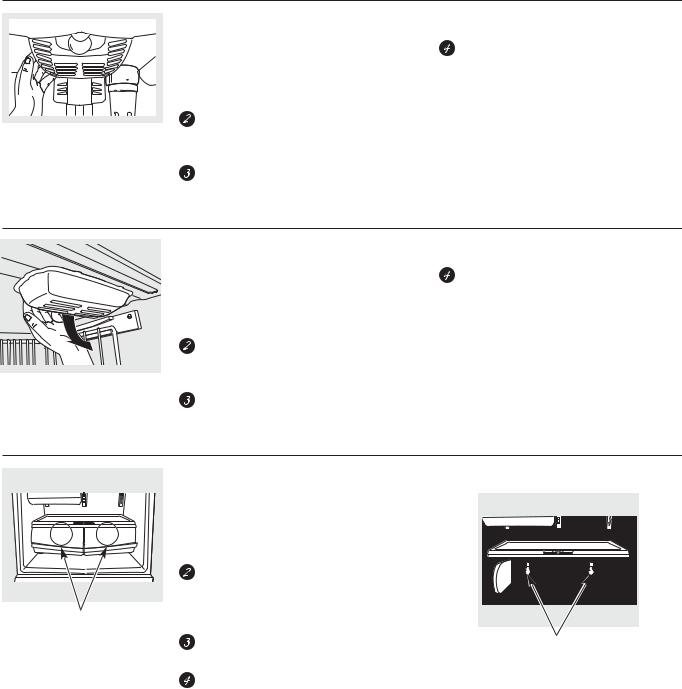
Replacing the light bulbs. |
GEAppliances.com |
|
|
Turning the control to the 0 (off) position does not remove power to the light circuit.
Refrigerator Lights
 CAUTION: Light bulbs may be hot.
CAUTION: Light bulbs may be hot.
 Unplug the refrigerator.
Unplug the refrigerator.
To remove the light shield, grasp the shield at the back and pull out to release the tabs at the back.
Rotate the shield down and then forward to release the tabs at the front of the shield.
After replacing with an appliance bulb of the same or lower wattage, replace the shield.
 Plug the refrigerator back in.
Plug the refrigerator back in.
NOTE: Appliance bulbs may be ordered from GE Parts and Accessories, 800.626.2002.
Appearance may vary
Freezer Light
 CAUTION: Light bulbs may be hot.
CAUTION: Light bulbs may be hot.
 Unplug the refrigerator.
Unplug the refrigerator.
Remove the freezer basket for access. The bulb is located at the rear of the freezer inside a light shield.
To remove, grasp the shield at the top and pull out to release the tabs at the bottom.
After replacing with an appliance bulb of the same or lower wattage, replace the shield and freezer basket.
 Plug the refrigerator back in.
Plug the refrigerator back in.
Middle Lights
 CAUTION: Light bulbs may be hot.
CAUTION: Light bulbs may be hot.
 Unplug the refrigerator.
Unplug the refrigerator.
The bulbs are located behind the crisper drawers. To remove the drawers, lift up slightly while pulling the drawer past the
Lights are behind |
stop location. |
|
crisper drawers |
Replace the bulbs with appliance bulbs |
|
|
Light Bulbs |
|
|
of the same or lower wattage. |
|
Replace crisper drawers by sliding them gently back onto the tracks while lifting up slightly.
 Plug the refrigerator back in.
Plug the refrigerator back in.
15
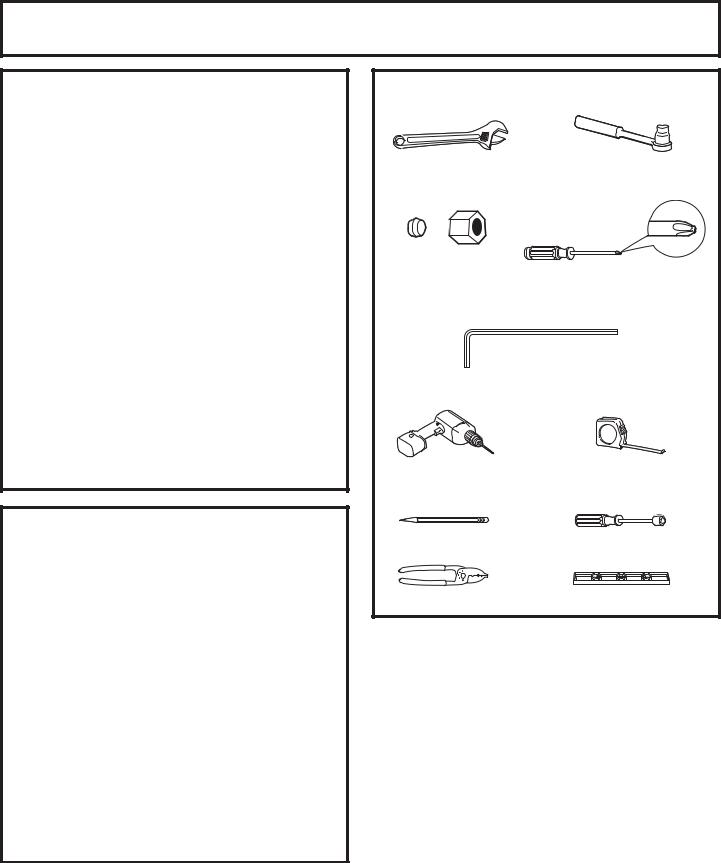
Installation |
Refrigerator |
Instructions |
Models 20, 22 and 23 |
Questions? Call 800.GE.CARES (800.432.2737) or visit our Website at: GEAppliances.com In Canada, call 1.800.561.3344 or visit our Website at: www.GEAppliances.ca
BEFORE YOU BEGIN
Read these instructions completely and carefully.
• IMPORTANT — Save these instructions for local inspector’s use.
• IMPORTANT — Observe all governing codes and ordinances.
•Note to Installer – Be sure to leave these instructions with the Consumer.
•Note to Consumer – Keep these instructions for future reference.
•Skill level – Installation of this appliance requires basic mechanical skills.
•Completion time – Refrigerator Installation
20 minutes
Water Line Installation
30minutes
•Proper installation is the responsibility of the installer.
•Product failure due to improper installation is not covered under the Warranty.
PREPARATION
MOVING THE REFRIGERATOR INDOORS
If the refrigerator will not fit through a doorway, the refrigerator door and freezer drawer can be removed.
•To remove the refrigerator door, see Step 1 in the Reversing the Door Swing section.
•To remove the freezer drawer, see the Removing the Freezer Drawer section.
WATER SUPPLY TO THE ICEMAKER AND DISPENSER (ON SOME MODELS)
If the refrigerator has an icemaker, it will have to be connected to a cold water line. A GE water supply kit (containing tubing, shutoff valve, fittings and instructions) is available at extra cost from your dealer, by visiting our Website at GEAppliances.com (in Canada at www.GEAppliances.ca) or from Parts and Accessories, 800.626.2002 (In Canada .888.261.3055).
TOOLS YOU MAY NEED
|
|
|
3/8” and 5/16” Socket |
|
|
|
|
|
Adjustable Wrench |
||
|
Ratchet/Driver |
||
|
|
|
|
|
|
|
|
|
|
|
|
1/4” Outer Diameter |
|
Compression Nut |
Phillips Head Screwdriver |
and Ferrule (sleeve) |
|
(icemaker models only) |
|
3/32”, 1/8” and 3/16” Allen
wrenches
1/8” Drill Bit and |
Tape measure |
Electric or Hand Drill |
|
Pencil |
1/4” Nut Driver |
|
|
Wire Cutters |
Level |
16

Installation Instructions
INSTALLING THE REFRIGERATOR
REFRIGERATOR LOCATION
•Do not install the refrigerator where the temperature will go below 60°F (16°C) because it will not run often enough to maintain proper temperatures.
•Do not install the refrigerator where the temperature will go above 100°F (37°C) because it will not perform properly.
•Install it on a floor strong enough to support it fully loaded.
CLEARANCES
Allow the following clearances for ease of installation, proper air circulation and plumbing and electrical connections.
|
Standard Depth |
|
Models |
Sides |
1/8” (3 mm) |
Top |
1” (25 mm) |
Back |
1” (25 mm) |
REMOVE TOP CAP (on some models)
•IMPORTANT NOTE: This refrigerator is 34-1/2” deep.
Doors and passageways leading to the installation location must be at least 36” wide in order to leave the doors and handles attached to the refrigerator while transporting it into the installation location. If passageways are less than 36”, the refrigerator doors and handles can easily be scratched and damaged. The top cap and doors can be removed to allow the refrigerator to be safely moved indoors. Start with Step A.
•If it is not necessary to remove doors, skip Step A. Leave tape and all packaging on doors until the refrigerator is in the final location.
•SKID REMOVAL: Tilt refrigerator to each side to remove skid.
•NOTE: Use a padded hand truck to move this refrigerator. Place the refrigerator on the hand truck with a side against the truck. We strongly recommend that TWO PEOPLE move and complete this installation.
ALocate and remove the two Phillips head screws on the top of the refrigerator. Remove the two screws on each side at the rear of the top cap. Lift off and remove top cap.
BRemove the fresh-food door. Refer to Steps 1 through 3 of “Reversing the Door Swing” section.
CRemove the bottom freezer drawer. Refer to “Removing Freezer Drawer” section.
DMove refrigerator to the installation location.
REMOVE TOP CAP (cont.) (on some models) REINSTALL DOORS, DRAWERS AND TOP CAP
ECarefully lower the door onto the center hinge. Reinstall top hinge. NOTE: Ensure the door is properly aligned to the case top to avoid readjustment of the door during top cap reinstallation.
FPlace cap over the top of the refrigerator. Reinstall the original screws in the top and back of the cap.
GReinstall the bottom freezer drawer. Refer to “Replacing the Freezer Drawer” section.
A
Top Hinge B
1CONNECTING THE REFRIGERATOR TO THE HOUSE WATER LINE
(icemaker and dispenser models)
A cold water supply is required for automatic icemaker operation. If there is not a cold water supply, you will need to provide one. See Installing the Water Line section.
NOTES:
•Before making the connection to the refrigerator, be sure the refrigerator power cord is not plugged into the wall outlet.
•If your refrigerator does not have a water filter, we recommend installing one if your water supply has sand or particles that could clog the screen of the refrigerator’s water valve. Install it in the water line near the refrigerator. If using GE SmartConnect™ Refrigerator Tubing Kit, you will need an additional tube (WX08X10002) to connect the filter. Do not cut plastic tube to install filter.
17

Installation Instructions
INSTALLING THE REFRIGERATOR (cont.)
1CONNECTING THE REFRIGERATOR TO THE HOUSE WATER LINE
(cont.)
AIf you are using copper tubing, place a compression nut and ferrule (sleeve) onto the end of the tubing coming from the house cold water supply.
If you are using the GE SmartConnect™ tubing, the nuts are already assembled to the tubing.
BIf you are using copper tubing, insert the end of the tubing into the refrigerator connection, at the back of the refrigerator,
as far as possible. While holding the tubing, tighten the fitting.
If you are using GE SmartConnect™ tubing, insert the molded end of the tubing into the refrigerator connection, at the back of the refrigerator, and tighten the compression nut until it is hand tight. Then tighten one additional turn with a wrench. Overtightening may cause leaks.
CFasten the tubing into the clamp provided to hold it in position. You may need to pry open the clamp.
One of the illustrations below will look like the connection on your refrigerator.
Icemaker-Ready models
Tubing |
|
1/4” Copper |
|
|
Tubing |
||
Clamp |
|
|
|
1/4” |
|
|
|
Compression |
|
|
|
Nut |
|
|
|
Ferrule |
|
|
|
(sleeve) |
|
|
|
Refrigerator |
|
|
|
Connection |
SmartConnect™ |
||
|
Tubing |
||
Icemaker-Installed Models |
|||
Refrigerator |
Ferrule |
1/4” |
|
(sleeve) |
Compression |
||
Connection |
|||
|
Nut |
||
|
|
||
SmartConnect™ |
|
|
|
Tubing |
|
|
|
|
|
1/4” Tubing |
|
|
|
Tubing Clamp |
|
18
2 TURN ON THE WATER SUPPLY
(icemaker and dispenser models)
Turn the water on at the shutoff valve (house water supply) and check for any leaks.
3 PLUG IN THE REFRIGERATOR
On models with an icemaker, before plugging in the refrigerator, make sure the icemaker power switch is set to the O (off) position.
See the grounding information attached to the power cord.
4 PUT THE REFRIGERATOR IN PLACE
Move the refrigerator to its final location.
5 LEVEL THE REFRIGERATOR
Adjustable legs at the front corners of the refrigerator should be set so the refrigerator is firmly positioned on the floor, and the front is raised just enough that the door closes easily when opened about halfway.
To adjust the leveling legs, turn the legs clockwise to raise the refrigerator, counterclockwise to lower it.
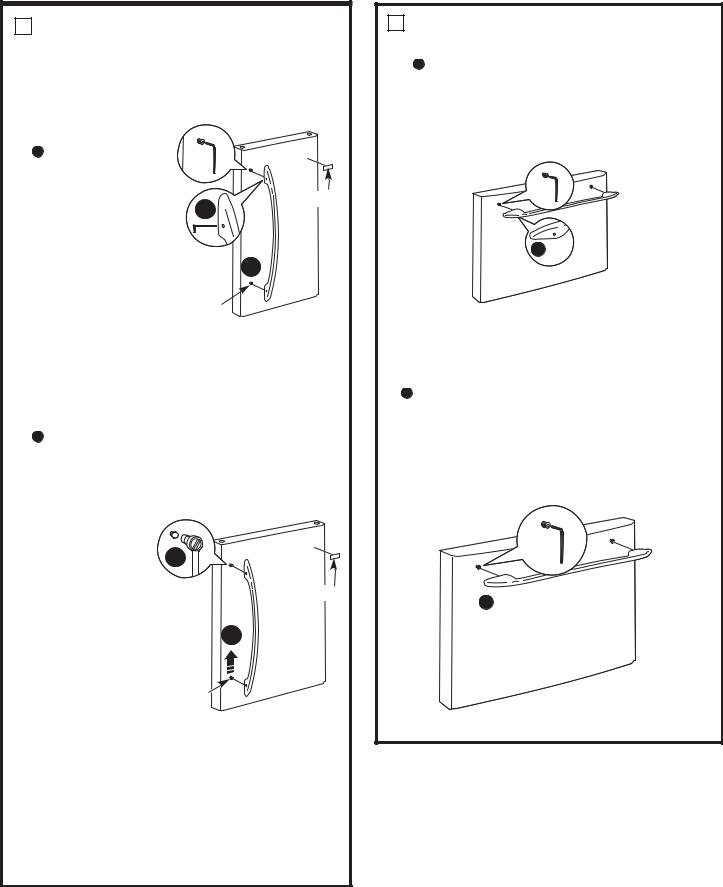
Installation Instructions
6REMOVE THE FRESH FOOD DOOR HANDLE
(For placement in the installation location or reversal of the handles – on some models)
Stainless steel (on |
|
|
some models): |
|
|
A REMOVING |
|
|
THE DOOR |
|
|
HANDLE: Loosen |
|
|
the set screws |
Badge |
|
with the 3/32” |
A |
|
Allen wrench |
|
|
and remove |
|
|
the handle. NOTE: |
B |
|
For Double Door |
|
|
models follow the |
Mounting |
|
same procedure |
Fasteners |
|
on the opposite |
(appearance may vary) |
|
door. |
||
|
Plastic handle (on some models):
AREMOVING THE DOOR HANDLE: Depress the tab on the underside of the handle and slide the handle up and off of the mounting fasteners.
 REVERSING THE DOOR HANDLE (on some models):
REVERSING THE DOOR HANDLE (on some models):
• Remove |
B |
|
the handle |
||
mounting |
|
|
fasteners with |
Badge |
|
a 3/16” Allen |
|
|
wrench and |
A |
|
transfer |
||
the handle |
|
|
mounting |
Mounting |
|
fasteners to |
||
Fasteners |
||
the right side. |
||
• Remove the |
(appearance may vary) |
|
logo badge. |
|
•Remove and transfer the plug button to the left side of the fresh food door. NOTE: Use a flat plastic edge to prevent damaging the door. Remove any adhesive on the door with a mild detergent. Remove the paper covering on the adhesive backing on
the logo badge prior to carefully attaching the badge to the door.
7 REMOVE THE FREEZER DOOR HANDLE
Stainless steel and plastic handles:
ALoosen the set screws located on the underside of the handle with the 1/8” Allen wrench and remove the handle.
NOTE: If the handle mounting fasteners need to be tightened or removed, use a 3/16” Allen wrench.
A 
(appearance may vary)
Plastic handle (on some models):
AREMOVING THE DOOR HANDLE: Depress the tab on the underside left of the handle and slide the handle left and off of the mounting fasteners.
Note: if the handle mounting fasteners need to be tightened or removed use a 3/16” Allen wrench.
A
(appearance may vary)
19
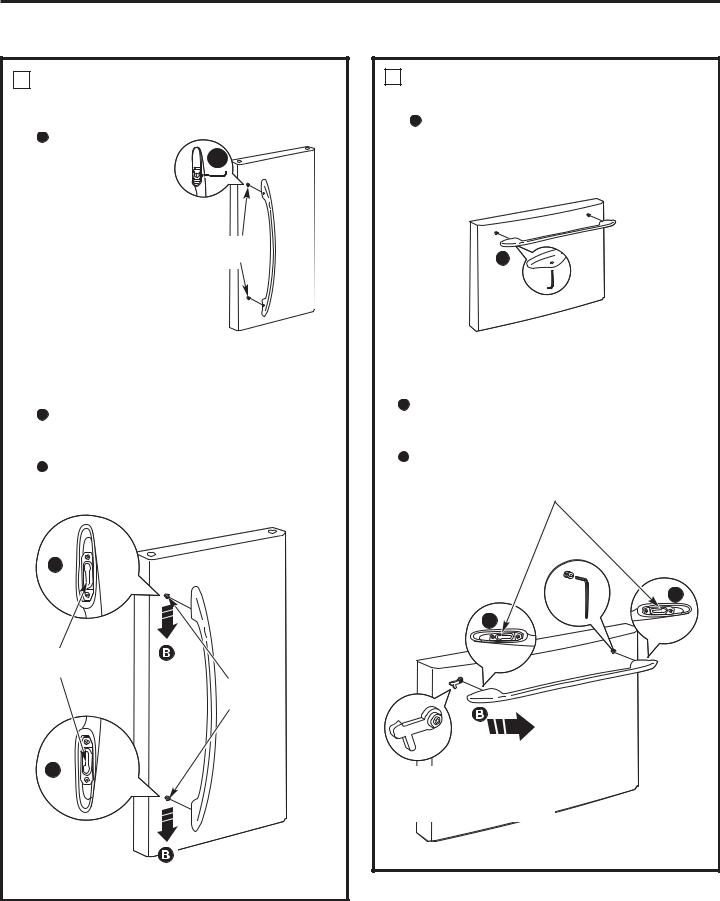
Installation Instructions
INSTALLING THE REFRIGERATOR (cont.)
8ATTACH THE FRESH FOOD DOOR HANDLE
Stainless steel handle:
A Attach the
handle to the |
A |
|
handle mounting |
||
|
||
fasteners and |
|
|
tighten the set |
|
|
screws with a |
|
|
3/32” Allen |
Mounting |
|
wrench. |
||
Fasteners |
||
NOTE: For |
||
|
||
Double Door |
|
|
models follow |
|
|
the same |
|
|
procedure on the |
(appearance may vary) |
|
opposite door. |
Plastic handle:
AAttach the handle to the handle mounting fasteners by aligning the slots with the handle mounting fasteners.
 Slide it down until it is firmly locked into position.
Slide it down until it is firmly locked into position.
A
Slots on back of handle
Mounting fasteners
A
(appearance may vary)
9 ATTACH THE FREEZER DOOR HANDLE
Stainless steel and plastic handles:
AAttach the handle firmly to the mounting fasteners and tighten the set screws on the bottom of the handle with a 1/8” Allen wrench.
A
(appearance may vary)
Plastic handle: (on some models)
AAttach the handle to the handle mounting fasteners by aligning the slots with the handle - mounting fasteners.
 Slide it right until it is firmly locked into position.
Slide it right until it is firmly locked into position.
Slots on back of handle
A
A
NOTE: Before attaching the handle, make sure the tab is oriented as shown.
(appearance may vary)
20
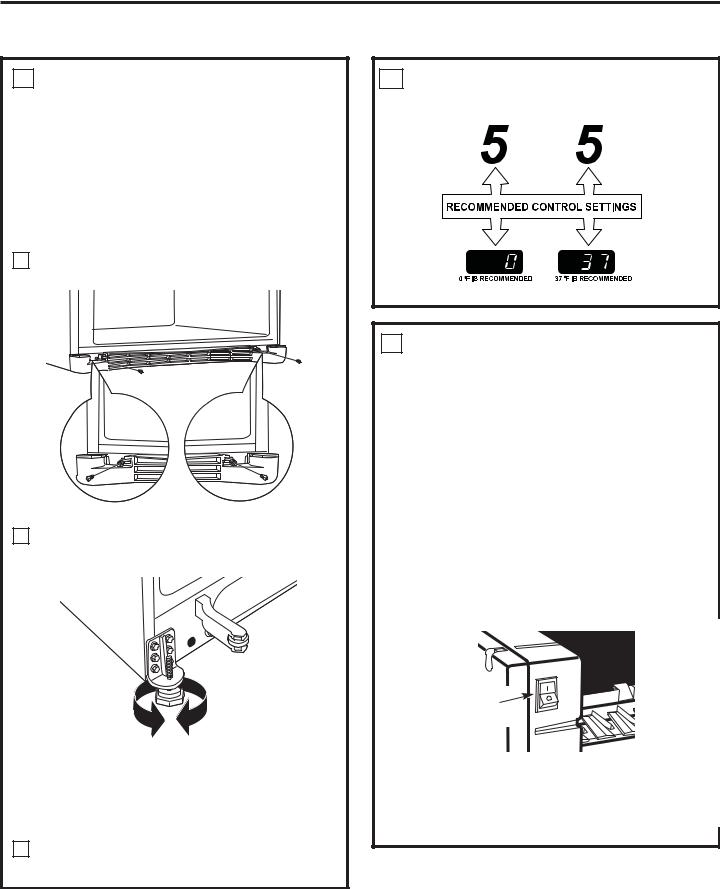
Installation Instructions
10 LEVEL THE REFRIGERATOR
The leveling legs have 2 purposes:
1)Leveling legs adjust so the refrigerator is firmly positioned on the floor and does not wobble.
2)Leveling legs serve as a stabilizing brake to hold the refrigerator securely in position during operation and cleaning. The leveling legs also prevent the refrigerator from tipping.
ARemove the grille by removing the two Phillips head screws.
BTurn the leveling legs clockwise to raise
the refrigerator, counterclockwise to lower it.
 CAUTION: To avoid possible personal injury or property damage,
CAUTION: To avoid possible personal injury or property damage,
the leveling legs must be firmly touching the floor.
CReplace the base grille by inserting the two Phillips head screws.
11 SET THE CONTROLS
Set the controls to the recommended setting.
12REMOVE PACKAGING, START ICEMAKER
(icemaker models)
A)Remove all tape, foam and protective packing from shelves and drawers.
B)Remove the tie downs from the freezer baskets.
C)Place half width basket onto drawer slides. See About the freezer section for instructions.
Set the icemaker power switch to the I (on) position. The icemaker will not begin to operate until it reaches its operating temperature of 15°F (–9°C) or below. It will then begin operation automatically. It will take 2–3 days to fill the ice bin.
Power switch
NOTE:
In lower water pressure conditions, the water valve may turn on up to 3 times to deliver enough water to the icemaker.
21
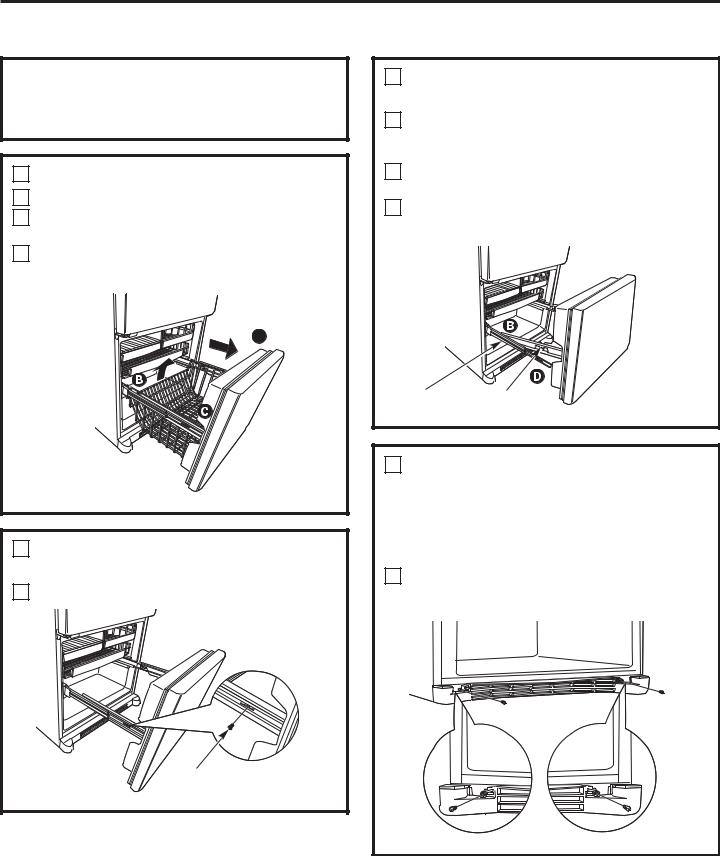
Installation Instructions
REMOVING THE FREEZER DRAWER
The freezer drawer can be removed, if needed, to fit through tight areas.
Read these instructions completely and carefully.
1 REMOVE THE BASKET
AOpen the freezer drawer until it stops.
BThe freezer basket rests on a frame inside the freezer drawer. Lift the basket up at the back.
CLift the front up and lift the entire basket up and out of the drawer.
A
2REMOVE THE DRAWER FRONT FROM THE SLIDES
A Remove the screw on each side of the railing.
2REMOVE THE DRAWER FRONT FROM THE SLIDES (cont.)
BLift up on both sides of the freezer drawer handle to separate the drawer railings from the rail assemblies.
CSet the drawer front on a non-scratching surface.
DPush the rail assemblies back into locking position.
|
|
|
|
|
|
|
|
|
|
Rail |
Assembly |
Drawer |
||
Assembly |
||||
|
|
|||
3 REMOVE THE BASE GRILLE
(if needed)
If, after removing the freezer drawer and refrigerator door, the refrigerator will still not fit through a doorway, the base grille can be removed.
A Remove the base grille by removing the screws.
Screw
22
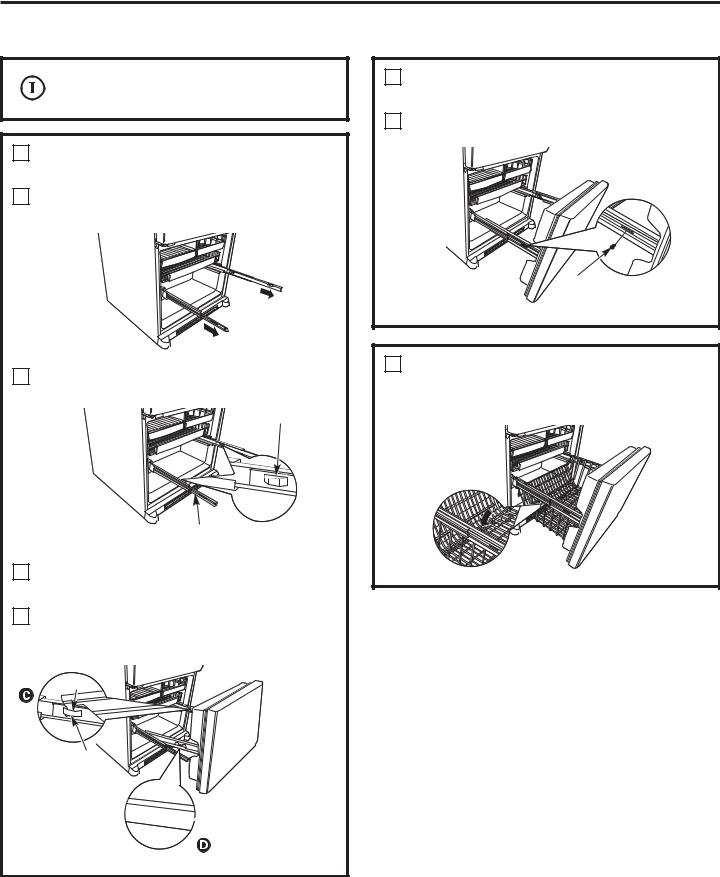
Installation Instructions
Two people may be required to complete this procedure.
1ATTACH AND SECURE THE DRAWER FRONT TO THE SLIDES
APull out the rail assemblies to the full length on each side of the cabinet.
BLocate the slots on the inside of the rail assemblies near the back.
Slot
Rail assembly
CInsert the hooks at the back of the drawer railings into the slots on the rail assemblies.
DLower the front of the drawer, making sure the tabs on the sides of the railings fit into the front slots in the rail assemblies.
Hook
Slot
 Tab
Tab
1ATTACH AND SECURE THE DRAWER FRONT TO THE SLIDES (cont.)
E Replace the screws on both rail assemblies.
Screw
2 REPLACE THE FREEZER BASKET
Replace the lower freezer basket by lowering it into the frame. 

23
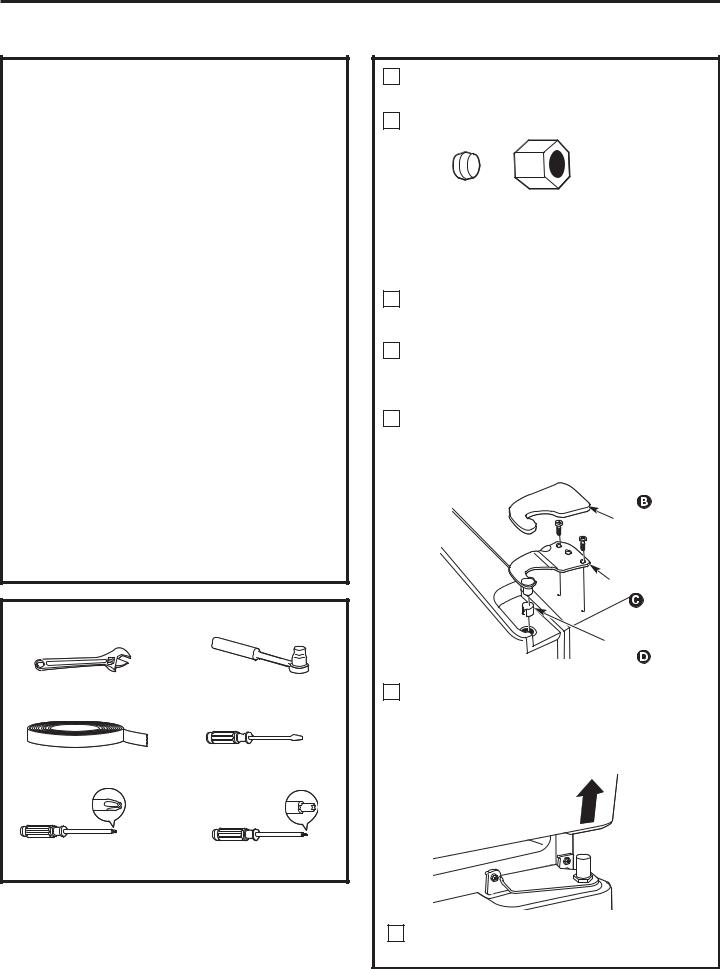
Installation Instructions
REVERSING THE DOOR SWING (Single Door Refrigerator Models only)
IMPORTANT NOTES
When reversing the door swing:
NOTE: Door swing is not reversible on stainless steel models.
•Read the instructions all the way through before starting.
•Parts are included in the door hinge kit.
•Handle parts carefully to avoid scratching paint.
•Set screws down by their related parts to avoid using them in the wrong places.
•Provide a non-scratching work surface for the doors.
IMPORTANT: Once you begin, do not move the cabinet until door-swing reversal is completed.
These instructions are for changing the hinges from the right side to the left side—if you ever want to change the hinges back to the right side, follow these same instructions and reverse all references to left and right.
•Once door swing is finalized, ensure the logo badge is properly aligned and permanently secured to the door by removing the adhesive cover on the back side. NOTE: A replacement logo badge is included in the hinge kit.
Unplug the refrigerator from its electrical outlet.
Empty all door shelves, including the dairy compartment.
TOOLS YOU WILL NEED
Adjustable Wrench |
5/16” Socket |
|
Ratchet/Driver |
||
|
||
Masking Tape |
Thin-blade Screwdriver |
|
|
|
|
|
|
|
|
|
|
|
|
|
|
|
|
|
|
|
|
|
|
|
|
|
|
|
|
|
|
|
|
|
||
Phillips Screwdriver |
Torx T-20 Driver |
|||||
|
|
|
|
|
|
|
1REMOVE THE REFRIGERATOR DOOR
A Tape the door shut with masking tape.
BRemove the hinge cover on top of the refrigerator door by carefully prying it up with a putty knife, if necessary.
CUsing a 5/16” socket ratchet/driver, remove the bolts securing the top hinge to the cabinet. Then lift the hinge straight up to free the hinge pin from the socket in the top of the door.
DCarefully remove the door thimble from inside the socket. This will be used again when reinstalling the door on the other side.
Hinge Cover |
Top Hinge
Door Thimble |
ERemove the tape and tilt the door away from the cabinet. Lift the door off the center hinge pin. Ensure that the plastic hinge pin thimble remains on the hinge pin or inside door hinge pin hole located in the bottom of the door.
FSet the door on a non-scratching surface with the inside up.
24
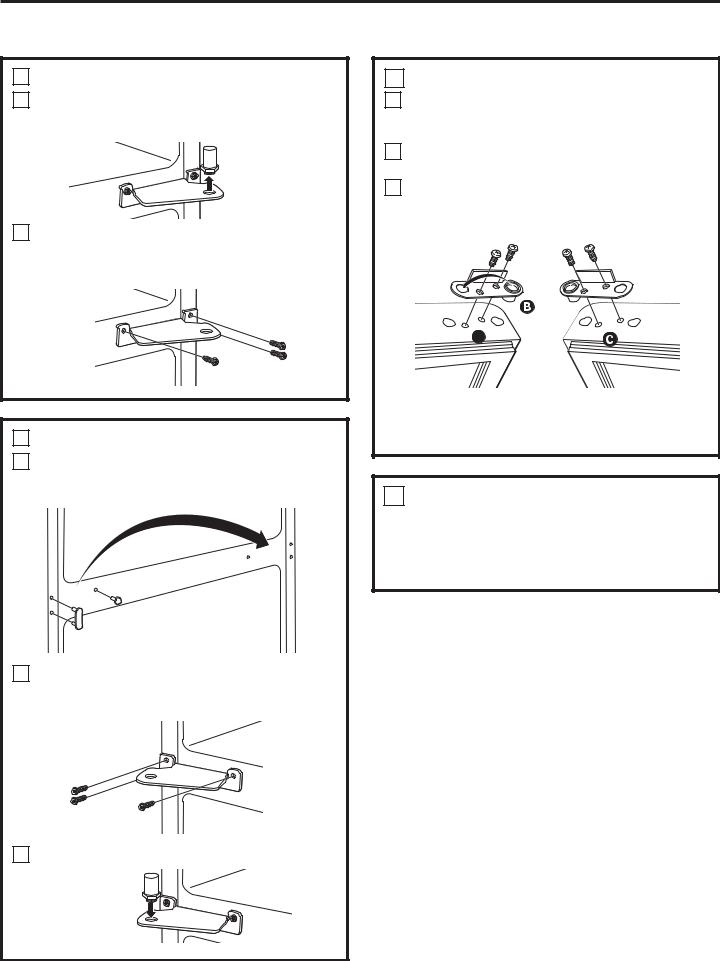
Installation Instructions
2 REMOVE CENTER HINGE
ARemove the hinge pin from the hinge bracket. The hinge pin will be used again with the new hinge bracket for the other side.
BUsing a 5/16” socket ratchet/driver, remove the bolts securing the center hinge to the cabinet. Set the bolts aside.
3 INSTALL CENTER HINGE
ATransfer the plug button and screw hole cover in the hinge holes on the left side to the right side.
BA new hinge bracket is required for the left side (supplied in the door hinge kit). Install the center hinge from the kit on the left side.
CInstall the hinge pin into the new hinge bracket.
25
4 TRANSFER REFRIGERATOR DOOR STOP
ARemove the door stop on right side of the bottom of the refrigerator door by removing the two screws.
BMove the plastic hinge hole thimble to the opposite hole.
CInstall the door stop on the left side, making sure to line up the screw holes in the door stop with the holes in the bottom of the door.
A
Bottom of |
|
Bottom of |
Refrigerator Door |
|
Refrigerator Door |
(Right Side) |
|
(Left Side) |
|
|
|
5TRANSFER REFRIGERATOR DOOR HANDLE TO RIGHT
Refer to Remove the Fresh Food Door Handle and Attach the Fresh Food Door Handle sections for instructions.
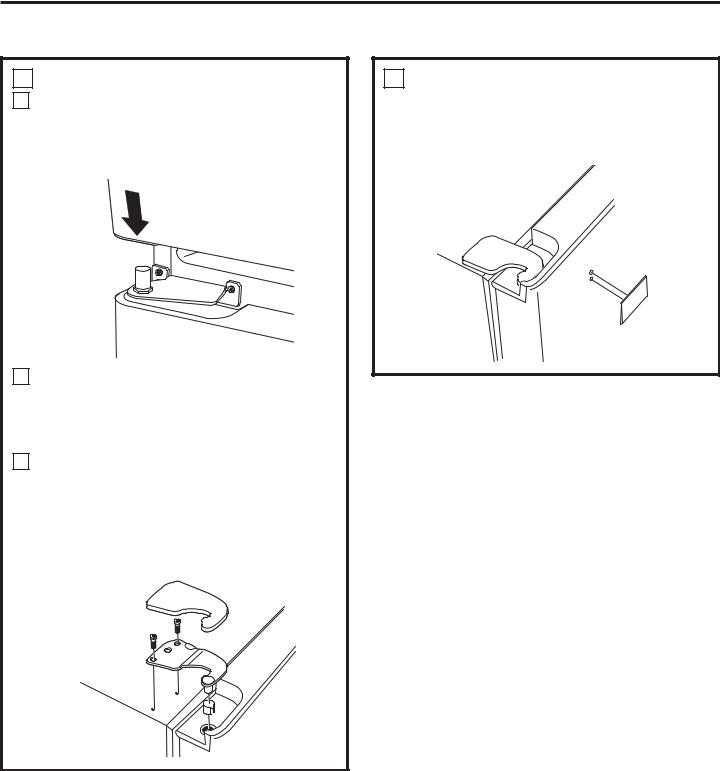
Installation Instructions
REVERSING THE DOOR SWING (cont.)
6
A
B
C
REHANG REFRIGERATOR DOOR
Lower the refrigerator door onto the center hinge pin. Ensure that the plastic hinge pin thimble is on the center hinge pin or inside door hinge pin hole located in the bottom of the door.
Insert the door thimble into the hinge hole on top of the refrigerator door and then insert the top hinge pin. Make sure the door is aligned with the cabinet. Attach the hinge
to the top of the cabinet loosely with the bolts.
Make sure the gasket on the door is flush against the cabinet and is not folded. Support the door on the handle side and make sure the door is straight and the gap between the doors is even across the front. While holding the door in place, tighten the top hinge bolts. Replace the hinge cover.
7 INSTALL THE LOGO BADGE
Remove the adhesive backing paper
and align the pins on the back of the badge with the holes in the door. Apply pressure to the badge to ensure it sticks to the door.
26
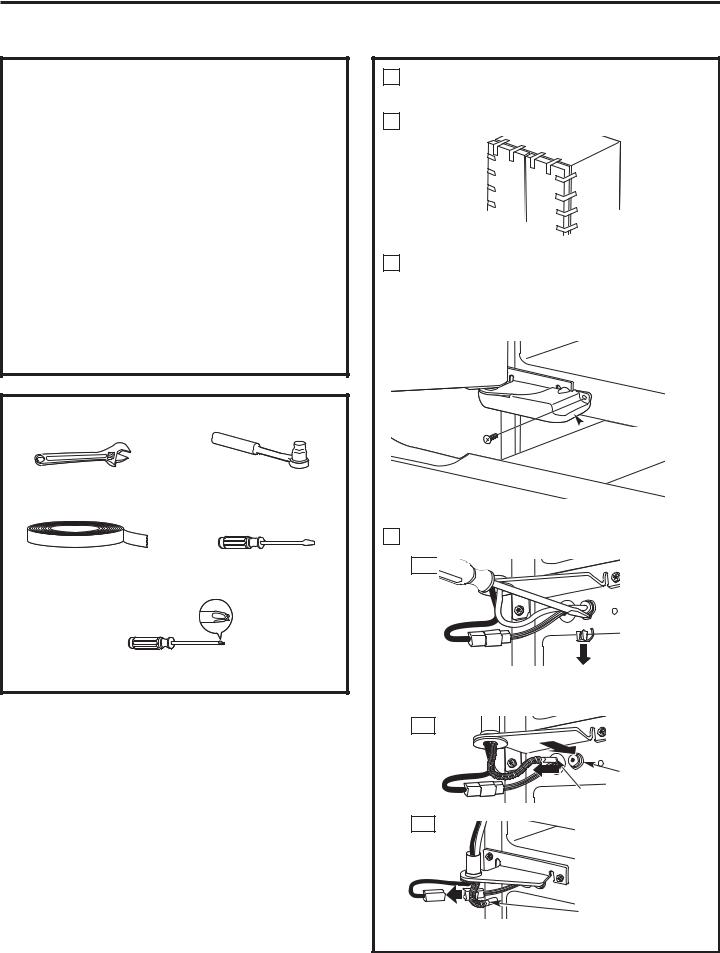
Installation Instructions
REMOVING THE DOORS (Double Door Refrigerator Models only)
IMPORTANT NOTES
NOTE: Door swing is not reversible.
•Read the instructions all the way through before starting.
•Handle parts carefully to avoid scratching paint.
•Set screws down by their related parts to avoid using them in the wrong places.
•Provide a non-scratching work surface for the doors.
IMPORTANT: Once you begin, do not move the cabinet.
These instructions are for removing the doors.
Unplug the refrigerator from its electrical outlet.
Empty all door shelves, including the dairy compartment.
TOOLS YOU WILL NEED
|
3/8” and 10 mm Socket |
|
|
||
Adjustable Wrench |
||
Ratchet/Driver |
||
|
||
|
Masking Tape |
Thin-blade Screwdriver |
|
|
Phillips Screwdriver
1REMOVE THE REFRIGERATOR DOORS
A Tape the doors shut with masking tape.
(for water dispenser models)
BStart with left-hand door first: Remove
the screw securing the center hinge cover, lift the hinge cover and place to the side on top of the refrigerator.
 Remove hinge cover (1 Phillips screw)
Remove hinge cover (1 Phillips screw)
(for water dispenser models)
C Remove water coupling and power coupling.
C1 

|
Water Coupling |
|
Remove the metal |
|
spring clip. Use a |
|
screwdriver to push |
|
the red plastic locking |
|
clip down and off. |
C2 |
|
|
Water Coupling |
|
Push red collar |
|
and hold. |
|
Pull tube. |
C3 |
|
|
Power Coupling |
|
Black mark |
|
flush with |
Pull apart |
collar assembly |
power coupling |
|
to disconnect |
|
27

Installation Instructions
REMOVING THE DOORS (cont.)
1REMOVE THE REFRIGERATOR DOORS (cont.)
DRemove the hinge cover on top of the refrigerator door by removing the Phillips head screw and pulling it up.
EUsing a 5/16” socket ratchet/driver, remove the bolts securing the top hinge to the cabinet. Then lift the hinge straight up to free the hinge pin from the socket in the top of the door.
Hinge Cover 
Top Hinge 

FRemove the tape and tilt the door away from the cabinet. Lift the door off the center hinge pin. Ensure that the plastic hinge pin thimble remains on the hinge pin or inside door hinge pin hole located in the bottom of the door.
2 REMOVE CENTER HINGE
Using a 5/16” socket ratchet/driver, remove the bolts securing the center hinge to the cabinet. Set the hinge and bolts aside.
3 REMOVE OPPOSITE DOOR
Follow the same procedure on the opposite door. There are no wires, water lines or center hinge covers on the opposite side.
4 REMOVE FREEZER DRAWER
Refer to the Removing the Freezer Drawer section for instructions.
GSet the door on a non-scratching surface with the inside up.
28

Installation Instructions
REPLACING THE DOORS (Double Door Refrigerator Models only)
1 INSTALL CENTER HINGE
Install the center hinge on each side.
2 REHANG REFRIGERATOR DOORS
ALower the refrigerator door onto the center hinge pin. Ensure that the plastic hinge pin thimble is on the center hinge pin or inside door hinge pin hole located in the bottom of the door.
Hinge Pin 


BSecurely tape the door shut with masking tape or have a second person support the door.
CRoute wires through bottom left hinge pin slot. Insert the top hinge pin into the hinge hole on top of the refrigerator door. Make sure the door is aligned with the cabinet and opposite door. Attach the hinge to the top of the cabinet loosely with the bolts.
Bottom
Left Hinge
Pin Slot
(appearance may vary)
DOn left-hand doors, pass the wires and water line through the center hinge pin. Then connect the water line and 4-pin connector.
Center Hinge Pin |
4-Pin |
Water Line |
|
Connector |
||
|
2 REHANG REFRIGERATOR DOORS (CONT.)
EMake sure the gasket on the door is flush against the cabinet and is not folded. Make sure the door is straight and the gap between the doors is even across the front. While holding the aligned door in place, tighten
the top hinge bolts. Replace the hinge cover and screw.
Hinge Cover 

Top Hinge
Bolts
(appearance may vary)
3 REPLACE OPPOSITE DOOR
Follow the same procedure on the opposite door. There is no water line or hinge cover.
4 ALIGN DOUBLE DOORS
If the top of the doors are uneven, first try to raise the lowest door by turning the leveling leg on the same side as the door until the doors are even. If the unit rocks, re-adjust the leveling legs to the extent that the unit is stable.
If the doors remain uneven, turn the adjustable pin to raise, or lower, the left door to match the right door. Use a 1/4” Allen wrench to turn the pin.

 Adjustable pin
Adjustable pin
5 REPLACE FREEZER DRAWER
Refer to the Replacing the Freezer Drawer section for instructions.
29
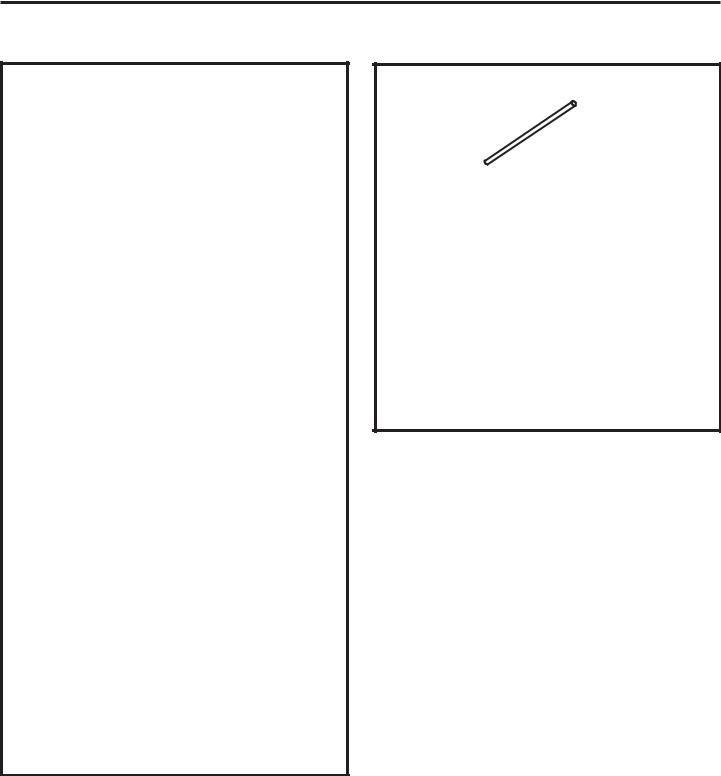
Installation Instructions
INSTALLING THE WATER LINE (ICEMAKER MODELS)
BEFORE YOU BEGIN
Recommended copper water supply kits are WX8X2, WX8X3 or WX8X4, depending on the amount of tubing you need. Approved plastic water supply lines are GE SmartConnect™ Refrigerator Tubing (WX08X10006, WX08X10015 and WX08X10025).
When connecting your refrigerator to a GE Reverse Osmosis Water System, the only approved installation is with a GE RVKit. For other reverse osmosis water systems, follow the manufacturer’s recommendations.
If the water supply to the refrigerator is from a Reverse Osmosis Water Filtration System AND the refrigerator also has a water filter, use the refrigerator’s filter bypass plug. Using the refrigerator’s water filtration cartridge in
conjunction with the RO filter can result in hollow ice cubes.
This water line installation is not warranted by the refrigerator or icemaker manufacturer. Follow these instructions carefully to minimize the risk of expensive water damage.
Water hammer (water banging in the pipes) in house plumbing can cause damage to refrigerator parts and lead to water leakage or flooding. Call a qualified plumber to correct water hammer before installing the water supply line to the refrigerator.
To prevent burns and product damage, do not hook up the water line to the hot water line.
If you use your refrigerator before connecting the water line, make sure the icemaker power switch is in the O (off) position.
Do not install the icemaker tubing in areas where temperatures fall below freezing.
When using any electrical device (such as a power drill) during installation, be sure the device is double insulated or grounded in a manner to prevent the hazard of electric shock, or is battery powered.
All installations must be in accordance with local plumbing code requirements.
WHAT YOU WILL NEED
•Copper or GE SmartConnect™ Refrigerator Tubing kit, 1/4” outer diameter to connect the refrigerator to the water supply. If using copper, be sure both ends of the tubing are cut square.
To determine how much tubing you need: measure the distance from the water valve on the back
of the refrigerator to the water supply pipe. Be sure there is sufficient extra tubing to allow
the refrigerator to move out from the wall after installation.
GE SmartConnect™ Refrigerator Tubing Kits are available in the following lengths:
6’ (1.8 m) – WX08X10006 15’ (4.6 m) – WX08X10015 25’ (7.6 m) – WX08X10025
30
